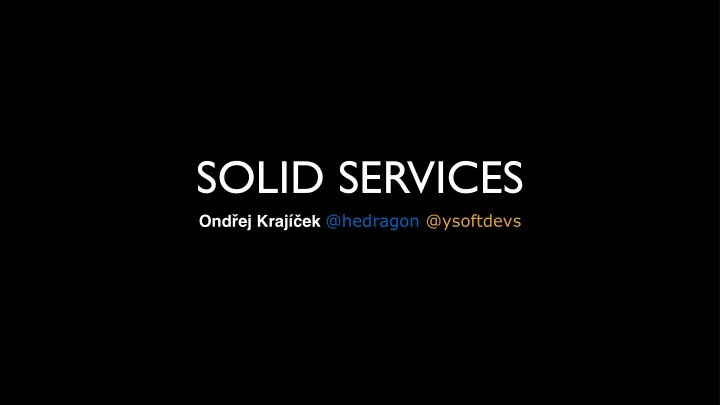

SOLID SERVICES Ond ř ej Krají č ek @hedragon @ysoftdevs
A Little Disclaimer • Today, I am trying to give you a perspective or - say - a point of view. • What I am presenting today are my own opinions. • But I am not presenting a new invention. And if I have learnt anything, it was from my cooperation with my colleagues at Y Soft . Hey guys... :-). • I am going to sometimes refer to buzzwords. I will try to make this explicit. • No services were harmed during preparation of this talk.
In a Galaxy Far Far Away... Geecon Prague 2014 Open Spaces with Bruce Eckel
Architecture (Latin architectura, after the Greek ἀρχιτέκτων – arkhitekton – from ἀρχι - "chief" and τέκτων "builder, carpenter, mason") is both the process and the product of planning, designing, and constructing buildings and other physical structures.
Why do we have software architecture?
Software Architecture gives answers to the most expensive questions.
Software Architecture is a decomposition of software products into systems, based on their responsibilities and interactions.
Architecture envelops software design.
Software Architecture is the servant of high-priority stakeholder values. Is as simple as possible, but not simpler . Is designed to be replaceable . (Tom Gilb)
Functional vs. Non-Functional Requirements
Functional vs. Non-Functional Requirements
Functions (Features) and Qualities (Quality Requirements)
Stakeholders Values Product Qualities System Qualities
Microservices Architectural Style
What is a SERVICE?
Microservices (2014) "In short, the microservice architectural style is an approach to developing a single application as a suite of small services , each running in its own process and communicating with lightweight mechanisms, often an HTTP resource API. These services are built around business capabilities and independently deployable by fully automated deployment machinery. There is a bare mininum of centralized management of these services, which may be written in different programming languages and use different data storage technologies." Martin Fowler
Microservices ( 2014 ) RPC ( 1991 ) • Single Service per Process • Single Service per Process • Lightweight Network Communication • Encapsulated Network and Interoperability Communication and Interoperability • Based on Business Concepts • Based on Business Concepts • Programming Language Agnostic • Programming Language Agnostic • Synchronous / Asynchronous • Synchronous / Asynchronous • Independent from others • Independent from others
Microservices vs. Monoliths By popular demand, the new technology is replacing the old, obsolete one.
Deja-Vu Tight vs. Loose Coupling • Local vs. Remote Procedure Call Pooling Resources • Database Connection Pools reused by several services Memory and Latency Conservation • Micro-Kernel (Mach) vs. Modular Kernel (WinNT) vs. Monolith (Linux) It all has been invented already (compare microservices to CSPs, WSRF, Globus Toolkit, OGSI, Agents, Actors, Data Driven Systems, Message Passing Systems, P2P Networks, etc.)
Let's Apply some Engineering...
SOLID • Single Responsibility Principle • Open for Extension / Closed for Modification Principle • Liskov Substitution Principle • Interface Segregation Principle • Dependency Inversion
How can we apply principles from structured / object oriented design to (micro)services?
A case for cohesion and coupling
Single Responsibility Principle
• Single Responsibility = A Case for Coupling and Cohesion • How to measure and evaluate cohesion? • REACHABILITY • http://www.cs.colostate.edu/~bieman/Pubs/tse98.pdf • Or a simple concept of semi-connected graphs might suffice (cohesion is the inverse of semi-connected components).
A D B C
F A D E B C
F A D E B C
Services abstraction: processes owning and exposing resources responding to messages Location Resource (PUT) Data Store for Forecast for Weather Berlin for Information Tuesday Forecast Resource
RESOURCE COHESION • There is a connection between resources iff… • There is a reference in a message directed at a resource (forecast refers to location). • References induces edges in resource graph, then… • Cohesion is inverse to the number of semi-connected components .
HR Module in ERP System a trivial example
Experience Salary Renumeration Employee Skills
Experience Salary Renumeration Employee Skills
Experience Salary Renumeration Employee Skills
Experience Salary Renumeration Employee Skills
A Case for Dependency Inversion
A problem of resource dependencies can be resolved on resource level. Location Resource (PUT) Data Store for Notify when Weather temperature in Information Berlin < 5 Temperature Trigger
A problem of resource dependencies can be resolved on resource level. Location (PUT) Give me URL for Berlin Resource (PUT) Give Weather me weather forecast URL for Resource this location (PUT) Notify Temperature when temperature in Trigger URL < 5
• The issue of trust … • The fact that I trust the client does not mean that I trust whatever resource URL the client throws at me. • The issue of availability … • What happens if the resource identified by the client is no longer available? • The issue of interoperability … • Does the service identified by the client speaks my language? A need to for standard / conventional contracts arises (again).
Food for Thought
• Brown, Simon. Distributed big balls of mud (http:// www.codingthearchitecture.com/2014/07/06/distributed_big_balls_of_mud.html) • Meilir Page-Jones. Practical Guide to Structured Systems Design. Prentice-Hall. ISBN: 007-6092032779 • Yourdon, Edward; Constantine, Larry L. (1979) [1975]. Structured Design: Fundamentals of a Discipline of Computer Program and Systems Design. Yourdon Press. ISBN 0-13-854471-9 • Gilb, Tom (2005). Competitive Engineering. Elsevier Butterworth-Heinemann. ISBN 0-7506-6507-6. • Brown, Simon. Software Architecture for Developers. https://leanpub.com/ software-architecture-for-developers
Principles over Patterns (and definitely much less buzzwords) THANK YOU!
Recommend
More recommend